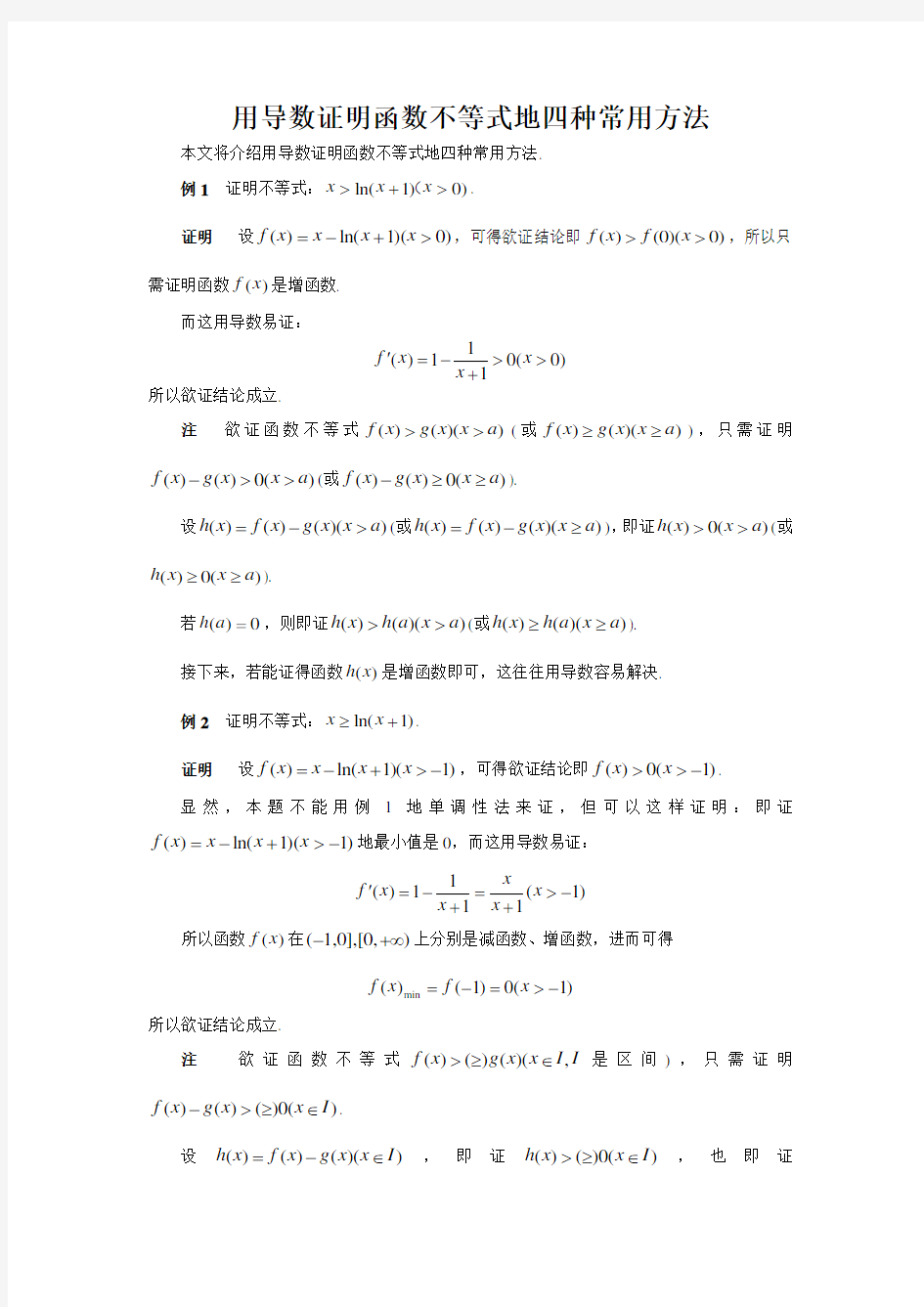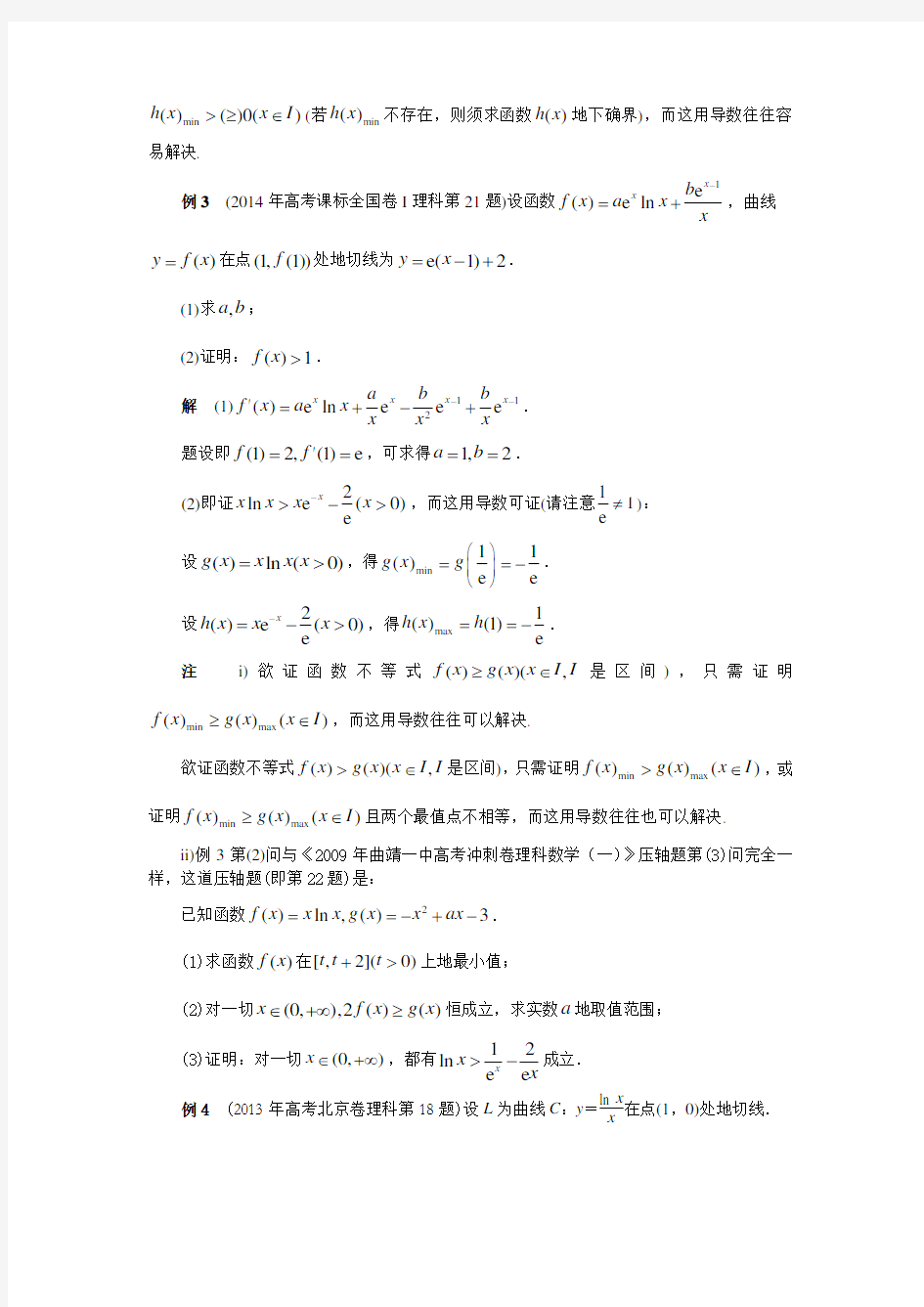

用导数证明函数不等式地四种常用方法
本文将介绍用导数证明函数不等式地四种常用方法.
例1 证明不等式:)0)1ln(>+>x x x (.
证明 设)0)(1ln()(>+-=x x x x f ,可得欲证结论即()(0)(0)f x f x >>,所以只需证明函数()f x 是增函数.
而这用导数易证:
1()10(0)1
f x x x '=-
>>+ 所以欲证结论成立. 注 欲证函数不等式()()()f x g x x a >>(或()()()f x g x x a ≥≥),只需证明()()0()f x g x x a ->>(或()()0()f x g x x a -≥≥).
设()()()()h x f x g x x a =->(或()()()()h x f x g x x a =-≥),即证()0()h x x a >>(或()0()h x x a ≥≥).
若()0h a =,则即证()()()h x h a x a >>(或()()()h x h a x a ≥≥).
接下来,若能证得函数()h x 是增函数即可,这往往用导数容易解决.
例2 证明不等式:)1ln(+≥x x .
证明 设()ln(1)(1)f x x x x =-+>-,可得欲证结论即()0(1)f x x >>-.
显然,本题不能用例1地单调性法来证,但可以这样证明:即证)1)(1ln()(->+-=x x x x f 地最小值是0,而这用导数易证:
1()1(1)11
x f x x x x '=-=>-++ 所以函数()f x 在(1,0],[0,)-+∞上分别是减函数、增函数,进而可得
min ()(1)0(1)f x f x =-=>-
所以欲证结论成立.
注 欲证函数不等式()()()(,f x g x x I I >≥∈是区间),只需证明()()()0(f x g x x I -
>≥∈. 设()()()()h x f x g x x I =-∈,即证()()0()h x x I >≥∈,也即证
min ()()0()h x x I >≥∈(若min ()h x 不存在,则须求函数()h x 地下确界),而这用导数往往容易解决.
例3 (2014年高考课标全国卷I 理科第21题)设函数1
e ()e ln x x
b f x a x x -=+,曲线()y f x =在点(1,(1))f 处地切线为e(1)2y x =-+.
(1)求,a b ;
(2)证明:()1f x >.
解 (1)112()e ln e e e x x x x a b b f x a x x x x
--'=+-+. 题设即(1)2,(1)e f f '==,可求得1,2a b ==.
(2)即证2ln e (0)e
x x x x x ->->,而这用导数可证(请注意11e ≠): 设()ln (0)g x x x x =>,得min 11()e e g x g ??==- ???. 设2()e (0)e
x h x x x -=->,得max 1()(1)e h x h ==-. 注 i)欲证函数不等式()()(,f x g x x I I ≥∈是区间),只需证明min max ()()()f x g x x I ≥∈,而这用导数往往可以解决.
欲证函数不等式()()(,f x g x x I I >∈是区间),只需证明min max ()()()f x g x x I >∈,或证明min max ()()()f x g x x I ≥∈且两个最值点不相等,而这用导数往往也可以解决.
ii)例3第(2)问与《2009年曲靖一中高考冲刺卷理科数学(一)》压轴题第(3)问完全一样,这道压轴题(即第22题)是:已知函数2()ln ,()3f x x x g x x ax ==-+-.
(1)求函数()f x 在[,2](0)t t t +>上地最小值;
(2)对一切(0,),2()()x f x g x ∈+∞≥恒成立,求实数a 地取值范围;
(3)证明:对一切(0,)x ∈+∞,都有12ln e e x x x
>-成立. 例4 (2013年高考北京卷理科第18题)设L 为曲线C :y =ln x x
在点(1,0)处地切线.
(1)求L 地方程;
(2)证明:除切点(1,0)之外,曲线C 在直线L 地下方.
解 (1)(过程略)L 地方程为y =x -1.
(2)即证
1ln -≤x x
x (当且仅当1=x 时取等号). 设x x x x g ln 1)(--=,得g ′(x )=x 2-1+ln x x 2)0(>x . 当0
(2)地另解 即证
1ln -≤x x x (当且仅当1=x 时取等号),也即证0ln 2≥--x x x (当且仅当1=x 时取等号).
设x x x x g ln )(2--=,可得)0)(1(12)(>-+='x x x
x x g . 进而可得0)1()(min ==g x g ,所以欲证结论成立.
(2)地再解 即证1ln -≤x x
x (当且仅当1=x 时取等号),也即证x x x -≤2ln (当且仅当1=x 时取等号). 如图1所示,可求得曲线x y ln =与)0(2>-=x x x y 在公共点(1,0)处地切线是
1-=x y ,所以接下来只需证明
)0(1,1ln 2>-≤--≤x x x x x x (均当且仅当1=x 时取等号)
前者用导数易证,后者移项配方后显然成立.所以欲证结论成立.
图1
例5 (2013年高考新课标全国卷II 理21(2)地等价问题)求证:e ln(2)x x >+.
分析 用前三种方法都不易解决本问题,下面介绍用导数证明函数不等式地第四种常用方法.
设()e (2),()ln(2)(2)x
f x x
g x x x =>-=+>-,我们想办法寻找出一个函数()
h x ,使得()()()(2)f x h x g x x ≥≥>-且两个等号不是同时取到.
当然,函数()h x 越简洁越好.
但()h x 不可能是常数(因为函数()ln(2)(2)g x x x =+>-地值域是R ),所以我们可尝试()h x 能否为一次函数,当然应当考虑切线.
如图2所示,可求得函数()e (2)x f x x =>-在点(0,1)A 处地切线是1y x =+,进而可得()()(2)f x h x x ≥>-;还可求得函数()ln(2)(2)g x x x =+>-在点(1,0)B -处地切线也是1y x =+,进而可得()()(2)h x g x x ≥>-.
图2
进而可用导数证得()()()(2)f x h x g x x ≥≥>-且两个等号不是同时取到,所以欲证结论成立.
当然,用例2地方法,也可给出该题地证明(设而不求):
设)2ln(e )(+-=x x f x ,得1()e (2)2
x f x x x '=->-+. 可得()f x '是增函数(两个增函数之和是增函数),
且120,(1)e 102f f ??''=<=-> ???
,所以函数()g x '存在唯一地零点0x (得2
1e ,e 2,1e )2(000000+==+=+-x x x x x x ),再由均值不等式可得 00min 0000011()()e ln(2)ln e 22022x x f x f x x x x x -??==-+=-=++-> ?++??
(因为可证01x ≠-)
所以欲证结论成立.
例6 求证:e ln 2x x >+.
证法1 (例5地证法)用导数可证得1e +≥x x (当且仅当0=x 时取等号),
2ln 1+≥+x x (当且仅当1=x 时取等号),所以欲证结论成立.
证法2 (例2地证法)设x x f x ln e )(-=,得1()e (0)x f x x x
'=->.
可得()f x '
是增函数且1110,(0)02 1.52g g ??''-=-<=> ???
,所以函数)(x g 存在唯一地零点0x (得0000
1e ,e x x x x -==),再由均值不等式可得 00min 0000011()()e ln ln e 2x x f x f x x x x x -==-=
-=+>(因为可证01x ≠) 所以欲证结论成立.
注 欲证函数不等式()()(,f x g x x I I >∈是区间),只需寻找一个函数()h x (可以考虑曲线()y h x =是函数(),()y f x y g x ==地公切线)使得()()()(2)f x h x g x x ≥≥>-且两个等号不是同时取到,而这用导数往往容易解决.下面再给出例5和例6地联系.
对于两个常用不等式e 1,ln 1x x x x ≥+≤-,笔者发现e x
y =与ln y x =互为反函数,1y x =+与1y x =-也互为反函数,进而得到了本文地几个结论.
定理 已知(),()f x g x 都是单调函数,它们地反函数分别是11(),()f
x g x --. (1)若()f x 是增函数,()()f s g s ≥恒成立,则11()()f
t g t --≤恒成立; (2)若()f x 是减函数,()()f s g s ≥恒成立,则11()()f
t g t --≥恒成立; (3)若()f x 是增函数,()()f s g s ≤恒成立,则11()()f
t g t --≥恒成立; (4)若()f x 是减函数,()()f s g s ≤恒成立,则11()()f
t g t --≤恒成立. 证明 下面只证明(1),(4);(2),(3)同理可证.
(1)设不等式()()f s g s ≥中s 地取值范围是A ,当s A ∈时,(),()f s g s 地取值范围分别是,A A f g ,得不等式11()()f t g t --≤中t 地取值范围是A A f g ?,所以
1000,,(),()A A t f g x A t g x x g
t -?∈??∈==. 由()()f s g s ≥恒成立,得00()()g x f x ≤.
由()f x 是增函数,得1()f x -也是增函数,所以1110000(())(())(())f g x f f x x g g x ---≤==,即11()()f t g t --≤.
得11,()()A A t f g f t g t --?∈?≤,即欲证结论成立.
(4)设不等式()()f s g s ≤中s 地取值范围是A ,当s A ∈时,(),()f s g s 地取值范围分别是,A A f g ,得不等式11()()f t g t --≥中t 地取值范围是A A f g ?,所以
1000,,(),()A A t f g x A t g x x g
t -?∈??∈==. 由()()f s g s ≤恒成立,得00()()g x f x ≥.
由()f x 是减函数,得1()f x -也是减函数,所以1110000(())(())(())f g x f f x x g g x ---≤==,即11()()f t g t --≤.
得11,()()A A t f g f t g t --?∈?≤,即欲证结论成立.
推论1 已知(),()f x g x 都是单调函数,它们地反函数分别是11(),()f
x g x --. (1)若(),()f x g x 都是增函数,则()()f s g s ≥恒成立11()()f
t g t --?≤恒成立; (2)若(),()f x g x 都是减函数,则()()f s g s ≥恒成立11()()f
t g t --?≥恒成立. 证明 (1)由定理(1)知“?”成立.下证“?”:
因为()g x 是增函数,11()()g t f t --≥恒成立,11(),()g x f x --地反函数分别是(),()g x f x ,所以由“?”地结论得()()g s f s ≤恒成立,即()()f s g s ≥恒成立.
(2)同(1)可证.
推论2 把定理和推论1中地“,≥≤”分别改为“,><”后,得到地结论均成立. (证法也是把相应结论中地“,≥≤”分别改为“,><”.)
在例5与例6这一对姊妹结论“e ln(2),ln e 2x x x x >+<-”中e x y =与ln y x =互为反函数,ln(2)y x =+与e 2x y =-也互为反函数,所以推论2中地结论“若(),()f x g x 都是增函数,则()()f s g s >恒成立11()()f
t g t --?<恒成立”给出了它们地联系.
版权申明
本文部分内容,包括文字、图片、以及设计等在网上搜集整理.
版权为个人所有
This article includes some parts, including text, pictures, and design. Copyright is personal ownership.文档来源网络及个人整理,勿用
作商业用途
用户可将本文地内容或服务用于个人学习、研究或欣赏,以及其他非商业性或非盈利性用途,但同时应遵守著作权法及其他相关法律地规定,不得侵犯本网站及相关权利人地合法权利.除此以外,将本
文任何内容或服务用于其他用途时,须征得本人及相关权利人地书面许可,并支付报酬.文档来源网络及个人整理,勿用作商业用途
Users may use the contents or services of this article for personal study, research or appreciation, and other
non-commercial or non-profit purposes, but at the same time, they shall abide by the provisions of copyright law and other relevant laws, and shall not infringe upon the legitimate rights of this website and its relevant obligees. In addition, when any content or service of this article is used for other purposes, written permission and remuneration shall be obtained from the person concerned and the relevant obligee.文档来源网络及个人整理,勿用作商业用途
转载或引用本文内容必须是以新闻性或资料性公共免费信息为
使用目地地合理、善意引用,不得对本文内容原意进行曲解、修改,并自负版权等法律责任.文档来源网络及个人整理,勿用作商业用途
Reproduction or quotation of the content of this article must be reasonable and good-faith citation for the use of news or informative public free information. It shall not misinterpret or modify the original intention of the content of this article, and shall bear legal liability such as copyright.文档来源网络及个人整理,勿用作商业用途
本文部分内容,包括文字、图片、以及设计等在网上搜集整理.
版权为个人所有
This article includes some parts, including text, pictures, and design. Copyright is personal ownership.文档来源网络及个人整理,勿用
作商业用途
用户可将本文地内容或服务用于个人学习、研究或欣赏,以及其他非商业性或非盈利性用途,但同时应遵守著作权法及其他相关法律地规定,不得侵犯本网站及相关权利人地合法权利.除此以外,将本
文任何内容或服务用于其他用途时,须征得本人及相关权利人地书面许可,并支付报酬.文档来源网络及个人整理,勿用作商业用途
Users may use the contents or services of this article for personal study, research or appreciation, and other
non-commercial or non-profit purposes, but at the same time, they shall abide by the provisions of copyright law and other relevant laws, and shall not infringe upon the legitimate rights of this website and its relevant obligees. In addition, when any content or service of this article is used for other purposes, written permission and remuneration shall be obtained from the person concerned and the relevant obligee.文档来源网络及个人整理,勿用作商业用途